Episodic or persistent low back pain often indicates that an inflammatory or degenerative-dystrophic disease is gradually developing in the body. Early diagnosis of this disease can increase the chances of a full recovery. Pain in the lumbosacral region of the spine may indicate osteochondrosis, a hernia, prostheses, infection, or problems with internal organs.
Why it hurts in the waist
If a person complains of painful manifestations of the lumbar spine, the doctor initially expresses doubts about the patient's musculoskeletal problems. And only after such diseases are ruled out, a thorough examination is carried out to assess the condition of the internal organs.
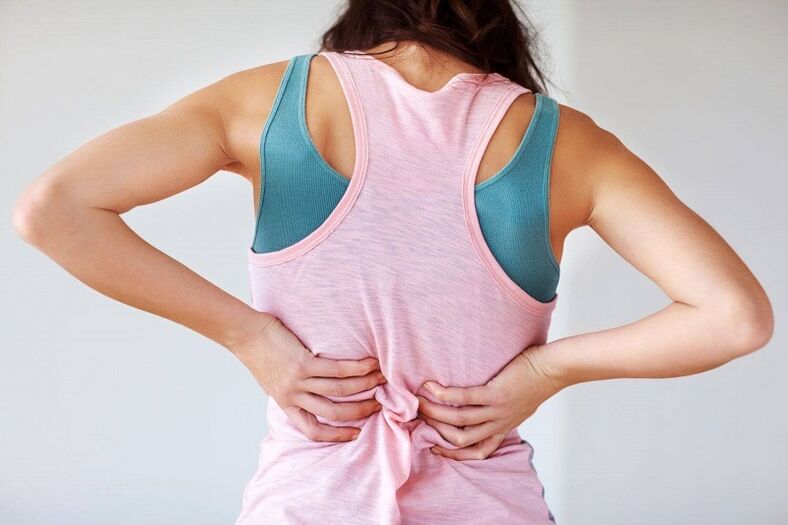
This is because there is a general innervation of the lumbar spine and intervertebral discs with the nerves of the nervous tissue. For this reason, the appearance of pain, for example in the digestive organs, may be given only in the lumbar region. Let’s take a closer look at some of the causes of low back pain.
Excessive loads
It is a relatively natural source of back pain. With strenuous physical labor or active sports training, muscle tissue is subject to excessive stress. It accumulates lactic acid, which irritates skeletal muscle tissues. As a result, in addition to the pain, the person notes a strong enough burning sensation. Any discomfort disappears after a short break as lactic acid is released from the muscles.
If you have low back pain every time you exercise, if their intensity remains unchanged for several hours, you should consult your doctor. Excessive exercise, lifting heavy objects often leads to the formation of microtraumas in the discs and vertebrae, the formation of diseases of a degenerative-dystrophic nature.
Osteochondrosis and intervertebral hernia
Stage I, II and III lumbar osteochondrosis is the leading cause of back pain. At an early stage the patient is concerned with slight discomfort, indicating slight destruction of the intervertebral discs.
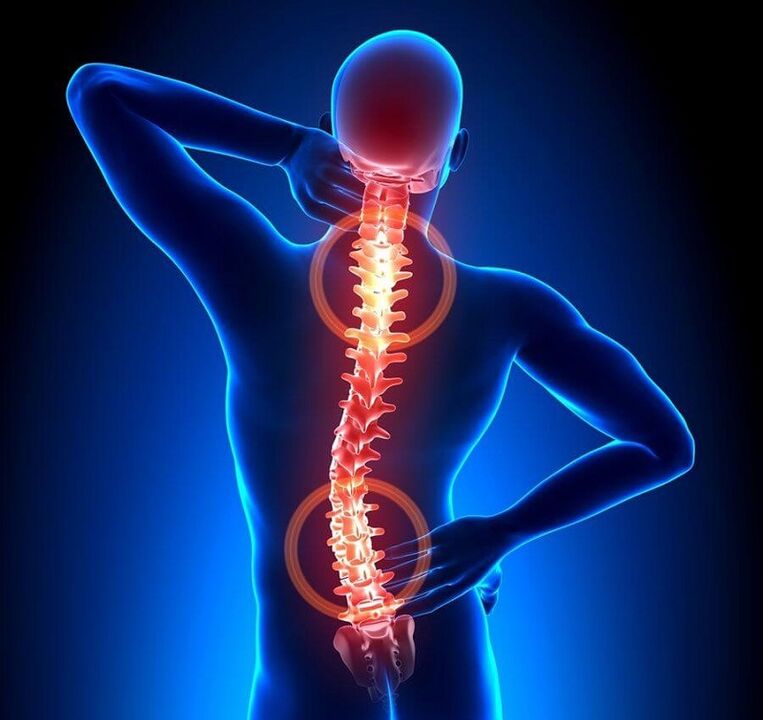
If the patient seeks help from a neurologist during this period, it is possible to completely cure the disease as well as partially restore the destroyed tissues. A sharp, strong pain that increases when the trunk is bent or twisted indicates serious damage to the spinal structure.
On the background of II or III radiological degree of osteochondrosis, the formation of a hernia or prosthesis is often observed. This causes excruciating pain and can also lead to serious complications - radicular syndrome, discogenic myelopathy.
Gynecological diseases
Discomfort in the lumbar spine often affects women diagnosed with adnexitis, an inflammation that simultaneously damages the ovaries and fallopian tubes (uterine appendages). In addition to pain syndrome, patients report discharge from the genitals, problems with conception, and menstrual irregularities.
A similar symptomatology is marked by inflammation of the uterine appendages, the formation of ovarian cysts, and the formation of polyps in the uterus.
Kidney disease
Since the kidneys are located in the lumbar region, when their function is reduced, a person may feel pain in the lumbar region. The fact that it affects the paired organs in the form of these beans indicates impaired urinary function, the appearance of purulent or bloody impurities in the urine, and a general deterioration in well-being.
Low back pain is often troubling in the presence of such diseases: cystitis (including hemorrhagic), glomerulonephritis, pyelonephritis, acute and chronic renal failure.
Carrying a baby
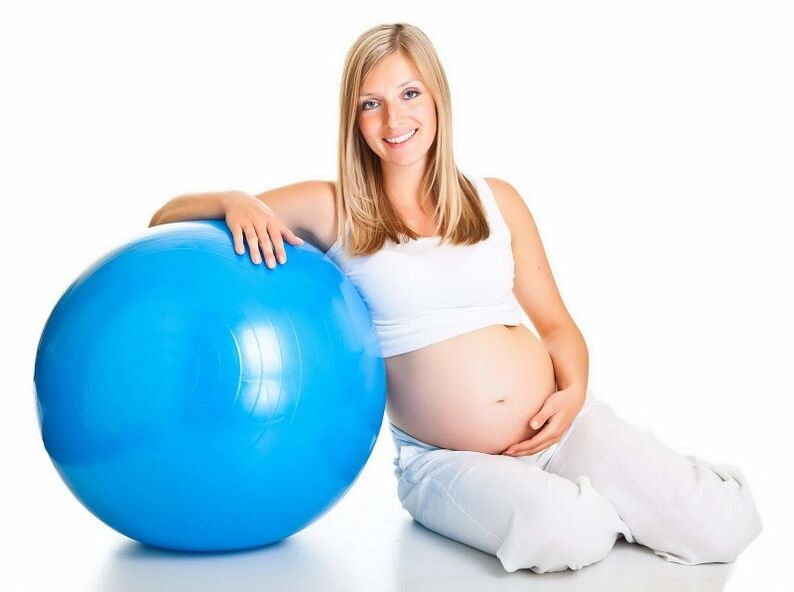
This is one of the natural factors that causes uncomfortable manifestations of the lumbar spine. When a woman gives birth to a future baby, the uterus and fetus grow in size, disrupting the nerve receptors below.
During the last trimester, the body of the future mother begins to produce a special hormone - relaxin. This causes the yolks, the tendons to relax to support the fetus in the birth canal. Because of this, the intensity of the pain can increase dramatically.
Endometriosis
It is a common gynecological disease in the background of which the tissue of the inner uterus grows outside it. Endometrioid tissue has an increased sensitivity to hormones synthesized by the body, for this reason, endometriosis manifests itself in the form of monthly bleeding. Because of this, inflammation develops, one of the signs of which is pain syndrome, with rays in the lumbar region of the spine.
Menstruation
Severe manifestations of moderate severity are manifested in half of women before menstruation or during bleeding. This pain is quite natural and disappears as soon as your period is over. Discomfort is also felt in the lower back.

The pathological etiology of low back pain during menstruation is indicated by the presence of dyspeptic disorders, diarrhea or constipation, frequent headaches and dizziness. In a similar situation a woman may be diagnosed with algomenorrhea or menstrual dysfunction.
Breast dimensions
In women with large breasts, the spinal column is heavily loaded. If the mammary glands are not properly distributed, the risk of degenerative-destructive processes increases. Women with large breasts often sneeze, which contributes to the deterioration of the spinal column.
Uncomfortable shoes
Painful sensations in the lumbar spine, which appear at the end of the working day, are a common condition of women who wear high-heeled tight shoes. This leads to disruption of blood vessels, disruption of blood circulation in the lower extremities and pelvic organs. As a result, malnutrition of the intervertebral discs occurs in the lumbar region, causing them to be destroyed. The situation is getting worse due to the increased stress on the spine.
Menopause
During the menopause in the female body there is a decrease in the production of estrogen, which is involved in the regulation of the recovery processes of the musculoskeletal system. The bone structure loses its ability to fully absorb the trace elements needed to restore it. It becomes brittle, which can lead to frequent fractures. Painful manifestations of the lumbar spine during menopause may indicate bone resorption, the formation of osteoporosis.
Excess weight
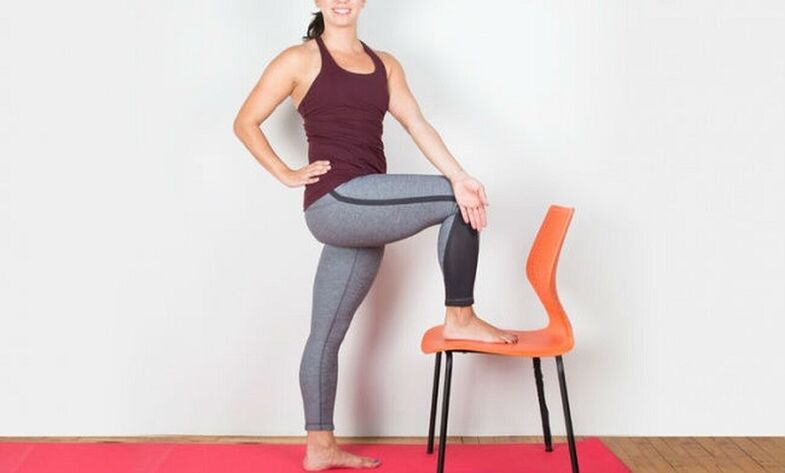
Excess weight is one of the causes of lumbosacral osteochondrosis. Excess weight increases the load on the intervertebral discs, leading to an increased risk of microtrauma with further destruction of the spinal tissues.
Excess weight usually does not eat well. His diet is rich in high-calorie foods, while fresh vegetables and fruits, which contain essential trace elements and vitamins, are not consumed in sufficient quantities. Increased loads, along with a lack of nutrients, indicate a tendency to form osteochondrosis of the lumbar region.
Oncology
Changes in the genetic structure of cells lead to disruption of their growth and proliferation regulation. As a result, there is abnormal proliferation of tissue, the formation of benign or malignant tumors.
Low back pain can occur in the setting of sensitive nerve receptors, disorders of the spine, soft tissues, and circulatory system. Calcium is absorbed by large numbers of neoplasms, causing a deficiency of this substance in the bone tissue, leading to thinning of the bones.
Hypothermia
Skeletal muscles in the lumbar region are often inflamed due to the influence of low temperatures. It becomes the cause of the formation of myositis - a disease manifested by local pain syndrome of damaged muscles. Its intensity increases significantly during movement and palpation. Against the background of the inflammatory process there is an increase in muscle tone, which causes less movement of the spinal cord.
Types of pain
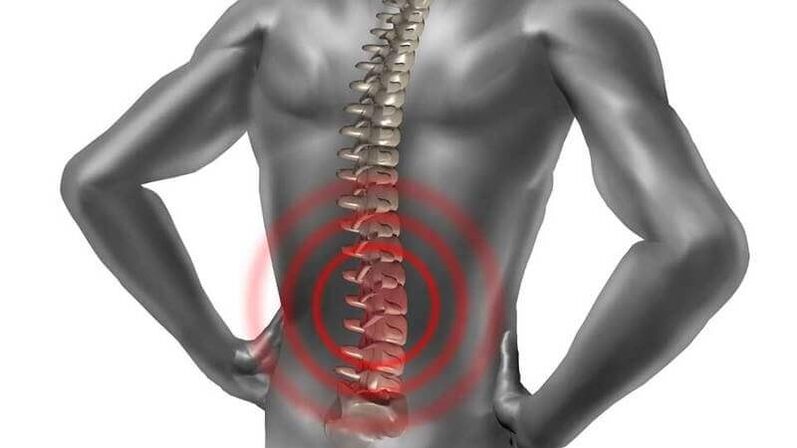
An initial diagnosis can be made based on a detailed description of the disturbing symptoms. During each disease the pain manifests itself in different severity, frequency, condition.
strong pain
This pain syndrome is characteristic of stages II and III of lumbar osteochondrosis. At this point, significant destruction has occurred in the intervertebral discs and their wear characteristics have been lost. They fail to soften the load during movement, which makes the spinal structure unstable.
This causes soft tissue compression. Acute pain begins to bother even in a motionless state, increases against the background of bending and twisting, loud laughter, coughing and wheezing. In addition, there is a feeling of "goose bumps" in the muscles and weakness.
Acute pain
The cause of acute pain syndrome is the capture of receptors in the spinal canal by osteophytes or discs. It is characteristic of the Lumbago attack, which is often manifested in rheumatic diseases, lumbosacral osteochondrosis, radiculopathies.
The painful sensations are so pronounced, piercing, burning that the patient is unable to move. Often, a person cannot straighten their spine for fear that pain will appear.
It is a dull pain
Dull, painful and severe lumbar spine pain is characteristic of diseases of the internal system, including diseases of the genitourinary and reproductive organs. Such discomfort may indicate the development of osteochondrosis, spondyloarthritis, spondyloarthritis.
The pain is not localized but can spread to the thighs, buttocks and ankles. Often, excruciating pain is evidence of a destructive process in the spinal column or inflammation in the internal system.
ᲥChronic pain

Pain in the lower back of a constant nature indicates the transformation of the disease into a chronic disease. It is sharp, strong during relapse, radiates to nearby areas of the body. Minor discomfort occurs during remission during hypothermia, physical exertion, exacerbation of other diseases, acute respiratory viral infections.
The pain syndrome increases amid bending, twisting of the body, walking up stairs, and long walks.
Diagnostic measures
Diagnosis of the disease is made on the basis of the patient's complaints, his visual examination, anamnestic data, the results of instrumental and laboratory diagnosis. X-ray examination is the most informative in identifying problems of the musculoskeletal system. In the resulting image you can see altered vertebrae, formed osteophytes (bone formations).
If the doctor suspects the development of a hernia, protrusion, diseases of the internal systems, ultrasound, MRI and CT are prescribed. Thanks to these diagnostic methods it is possible to find out where the disease is localized, to assess the degree of progression of inflammation.
Clinical examination of blood and urine is mandatory. If systemic disease is suspected (gout, rheumatoid arthritis), a biochemical, serological examination is performed.
Which doctor should I go to
Often, back pain occurs after an injury - spinal subtype, severe bruising, spinal canal damage. In such a situation you will need the help of a traumatologist.
You can also see a therapist. Such a doctor can diagnose diseases of the spinal cord, internal systems. After studying the results of the diagnosis, he will determine which narrow specialist consultation (rheumatologist, neuropathologist or orthopedist) is needed to determine further treatment.
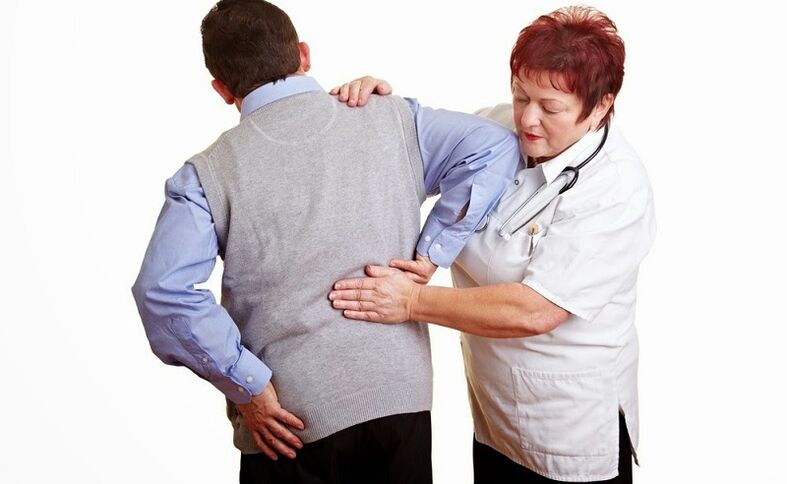
First aid
If there is severe pain, the victim should be placed on a hard surface in a position in which the discomfort becomes less pronounced. You can close the elbows slightly bent and close the folded blanket under them. You can take any nonsteroidal anti-inflammatory drug to relieve the pain quickly.
Therapeutic actions
Analgesics can help you get rid of back pain. Their effect will not last long if you do not properly treat the underlying disease. Some pathologies of the internal systems are well treated, including oncology. But complete recovery of destroyed intervertebral discs and deformed spine against the background of osteochondrosis is impossible. The goal of therapy is to achieve stable remission, during which pain in the lumbar spine does not bother.
Drug therapy
First of all, non-steroidal anti-inflammatory drugs (NSAIDs) in the form of a tablet or capsule are prescribed for back pain.
In case of oncological diseases resort to the help of narcotic analgesics. If pain occurs due to skeletal muscle spasm, muscle relaxants are indicated.
Analgesics are also prescribed to treat diseases of the internal systems.
Treatment with ointments and gels
Ointments and gels are used to relieve mild to moderate discomfort in the lumbar region. Topical medications are also included in therapeutic regimens to reduce the dose of injections and tablets of the drug, to reduce the pharmacological load.
In case of back pain, the use of external agents from the following groups may be prescribed:
- Nonsteroidal anti-inflammatory drugs - have anti-inflammatory, analgesic and decongestant action.
- Warming gels and ointments - have analgesic, local irritating and distracting effects.
- Chondroprotectors against the background of osteochondrosis - have analgesic and anti-inflammatory action, stimulate disc recovery.
Injections
Choosing pain relief, the doctor based on the type of disease, its course, the severity of the pain syndrome. To relieve severe pain they often resort to medication blockade using glucocorticosteroids and anesthetics. The use of hormonal agents is quite harmful to the body, so such procedures can be performed a maximum of 1 time in 1-3 months.
To relieve severe pain, nonsteroidal anti-inflammatory drugs are prescribed in the form of intramuscular injections.
Physiotherapy
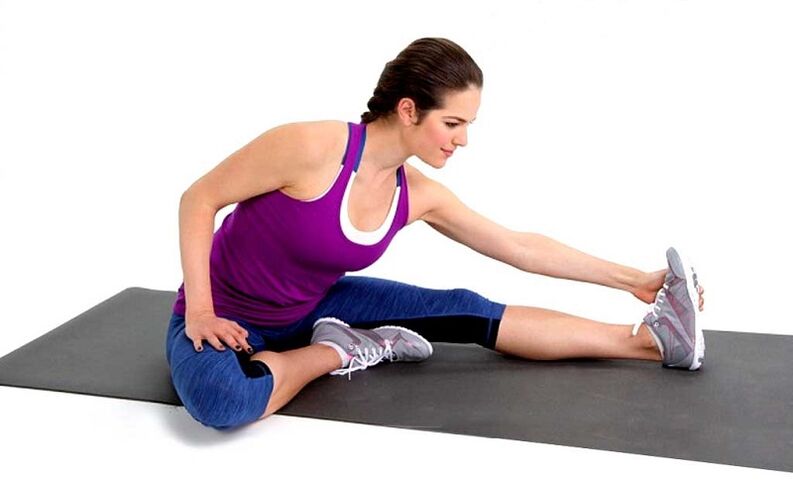
If the disease has already been diagnosed, or to prevent its development, experts advise patients to conduct therapeutic gymnastics exercises every day. This will help:
- Improving blood circulation in the lumbar region;
- Strengthening the spinal muscular framework;
- Reduce the intensity of pain.
The gymnastics complex is designed by the attending physician taking into account the type of disease, existing complications and the patient's physical condition.
Massage treatment
To improve the blood and nutrient supply to the tissues, to normalize skeletal and smooth muscle tone, to strengthen the muscles, it is recommended to conduct a massage:
- Classic;
- Point;
- Segmental;
- Canned
Massage is prescribed both for therapeutic purposes, as well as to prevent the development of exacerbation of the chronic course of pathology.

Heat and cold treatment
The effect of heat on the lumbar spine helps to eliminate pain, but only after the acute inflammatory process has stopped. For these purposes, a heating pad, warming ointment or gel, bath is suitable.
Adaptation systems are activated under the influence of cryotherapy (cold treatment). At the center of this physiotherapy procedure, the body’s response is not hypothermia of the outer layers of the skin.
Preventive actions
It is possible to prevent pain in the lumbar spine by eliminating the factors that can cause the problem to appear. It is essential to stop walking in high-heeled shoes to minimize the consumption of very high-calorie foods. Regular sports, swimming and yoga are good prevention.















































